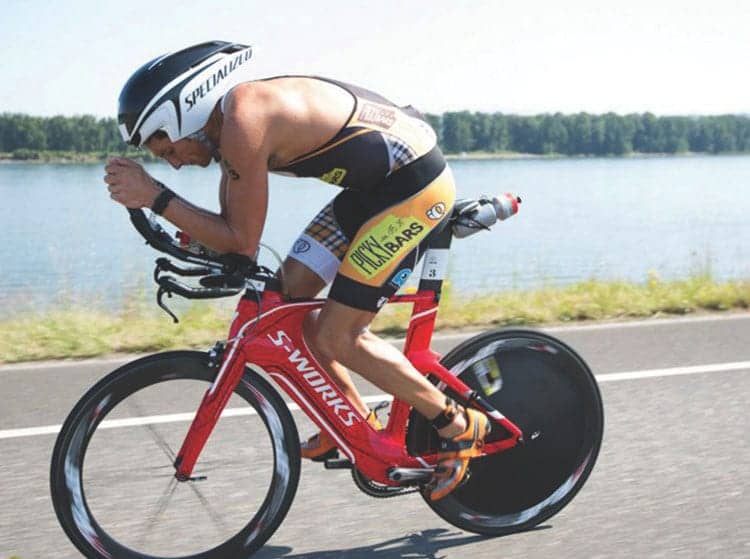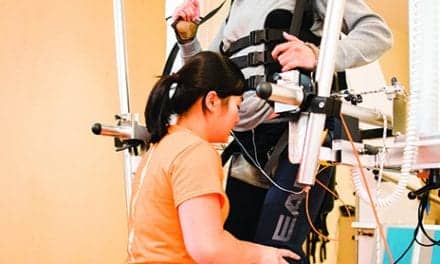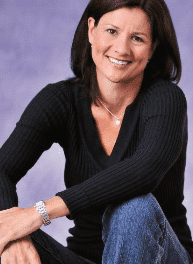Recalibrating the mind and initiating physical rehabilitation for the body post-severe injury tests the will of both therapist and athlete.
By Brittan West, associate editor

UNFAVORABLE ODDS
At the age of 24, athlete Jesse Thomas (pictured above) faced the possibility of being counted among this population. A 2004 bicycling accident caused the accomplished triathlete to sustain multiple C1-2 fractures, ultimately leading to the fusing of his neck and the initiation of physical therapy.
During the accident, Thomas sustained a Jefferson’s fracture, pushing the conical part of the skull through C1, fracturing it into 4 pieces. Thomas’ chin was pulled down into his chest while his head took the brunt of the impact. The force also broke the odontoid process of C2, leaving it angled and pointing in, “within some very small measurement of the spinal column,” according to Thomas.
After being driven to the hospital by a friend and walking in to await evaluation, Thomas’ physician characterized the situation as incredible and cautioned Thomas to be very still during his evaluation, as his spinal column “was completed exposed without any structural integrity in that part of his neck.” Thomas adds that his physician attributed his lack of paralysis to a combination of good fortune and the enhanced strength of his neck muscles, which had been conditioned by bicycling from 20 to 25 hours for 4 to 6 months.
Morrison notes that in her experience, she has not seen many C1-2 injuries return to unassisted walking, estimating that she had seen a total of perhaps 5 per year. “Often times clinicians can predict if a person is more or less likely to return to walking. Some of these predictors include—does the person have sacral sensation? If so, this is an indication the injury is incomplete. Does the person have an initial lower extremity motor score of over 25? If so, they are more likely to walk post injury,” she explains.
Functional outcomes for the C1-2 injury vary greatly, ranging from the inability to move from the chin down, lifelong dependence on a ventilator for breathing and on others for daily care—to the ability to move and perform all of the activities they were prior to the SCI, “the latter being more rare from my experience as a physical therapist,” Morrison says.
ENGINEERING A RETURN TO FUNCTION
ENGINEERING A RETURN TO FUNCTION
Physical activity, particularly in a C1-2 injury, sets the stage for prevention of muscle atrophy as well. While Thomas’ therapist introduced a variety of exercises, the treatment to prevent atrophy often depends on the level, severity, and type of injury. Morrison points out that while some C1-2 patients do not atrophy as a result of involuntary muscle spasms, others have access to activity-based preventions. These include lower extremity electrical stimulation bicycling, and body weight support treadmill training. Other patients may not have any options for keeping muscles toned.
“However, what we do know is that all persons with spinal cord injury must pay attention to their bodies. After a spinal cord injury, every body system is affected: heart, lungs, musculoskeletal, bowel, bladder, etc. The more a person can keep their bodies healthy, the more likely they are to be able to take advantage of science down the road,” she says.
As Thomas’ comfort in supporting his head increased, the amount of resistance integrated into the mobilization exercises did as well, beginning with Thomas lying on his back and lifting his head off the ground, repeating the movement on his sides. To create resistance, Thomas’ therapist pushed on the side of the head or held it while Thomas tried to push against it. Eventually this was done with bands. To pull the shoulders back and loosen the chest, foam rollers were also integrated and used while sitting on a roller positioned horizontally, accompanied by another roller set vertically along the spine to loosen areas of the back while forcing the thoracic spine to arch across it.
The prescribed exercises eventually broadened to target improvement in Thomas’ upper body strength, including Y-T-W exercises, in which the patient must hold the hands in front of the body and drive them back. Light therapy bands and small 3- to 5-pound weights were added to increase the challenge in executing these movements. To further complement these movements and optimize strength building in the neck, Thomas’ therapist prescribed the use of the shoulder press, reverse fly resistance, and weightlifting routines.
Thomas also maintained fitness and general blood flow through the use of a recumbent stationary bicycle, riding the machine 6 to 8 weeks post-injury for 10 minutes at a time. To accommodate Thomas’ progress, yet also remain sensitive to his inability to support his neck leaning forward, the bicycle’s handlebars were positioned high then gradually lowered over the course of therapy as his neck gained strength. The work completed by Thomas and his therapist following the first 16 to 20 weeks of therapy allowed the program to evolve, integrating increased athletic movements and strength training performed at the clinic and at home to support his goal to return to full athleticism.
Human assistance rather than engineered adaptions or modifications promoted his successful completion of his physical therapy exercises early on post-surgery, according to Thomas. In spite of his injury, pre- and post-therapy Thomas also did not require any devices to assist him in standing, squatting, or walking.
“I think it was about 3 or 4 days post-surgery that I finally walked. I went straight into walking, I didn’t move around in a wheelchair at all before that. I remember it vividly because it was the day my now wife came to visit me…we walked down the hall together,” Thomas explains.
FIT TO COMPLY
The impact of these traits served not only to spur his recovery, but also as a catalyst for frustration. “My experience was that I would improve fast, faster than expected, and always get to fitness quickly…and it just didn’t feel like that. It felt like it took forever, and that was the hardest part,” Thomas acknowledges.
“Athletes are very motivated individuals and they have a rehabilitation work ethic far beyond the average individual who is not involved in sports,” Morrison notes, adding that athletes “often have a much better body awareness too. They can pick up skills much quicker than somebody who has never done sports. They are just more aware of what their body needs to do to complete a task.”
The relentless push toward full rehabilitation during Thomas’ therapy mirrors the training linked to all forms of competition, which aim to significantly surpass expectations for how a body will perform and complete the task at hand. “It was that same kind of mind-set and experience with putting in work and going through pain. I was very familiar with working hard and enduring pain,” Thomas says.
Thomas’ physical fitness played a key role not only in his compliance with the program, but also in streamlining the progression of his rehabilitation in general. “Since rehabilitation is such a short process now (usually a 30-day length of inpatient hospital stay when 29 years ago it was closer to 90), it helps to have strong muscles from the beginning rather than taking up the full 30 days just working on strengthening. If they come to rehabilitation in better shape, therapists can get to work on teaching skills rather on focusing on strengthening first,” Morrison says.
RE-DEFINING FULL REHABILITATION
RE-DEFINING FULL REHABILITATION
Each phase of treatment customized for Thomas by his physician and therapist ultimately demonstrated its ability to fit his long-term goal to continue on as a professional athlete, yet it was not without challenges. While the program brought Thomas back into shape to train, it also translated into what he calls a “full circle process,” in which for the first 6 months Thomas focused heavily on returning to competition and then gradually settled into the desire to get back to “being normal.”
At 15 months post-injury, “I was just a normal guy for a long time, and I didn’t come back to athletics [and] to competing for another few years after that. It was that process of getting back to normal and ultimately then being comfortable with it that enabled me to think again about pursuing athletics and really doing it without any worry about the impact that my injury was going to have on my athletic career,” Thomas confides.
As a result of the rotation loss between the C1 and C2 vertebrae, the long-term outlook for range of motion (ROM) in Thomas’ neck will continue to range from 50% to 60% of what is considered “normal.” The impact also surfaces during Thomas’ competitive activities, such as biking and swimming. The loss forces Thomas to, “rotate extra onto my side to breathe…In cycling, particularly in a triathlon, you ride in a time trial position, so you are kind of resting on your elbows….head down, flat back. Then the way you see is by tilting your neck back as far as you can, so this is effecting me because I can’t tilt my neck back that far. In order to just be able to see down the road, I have to ride more upright than the others guys do.”
Despite the potential risks inherent in his surgery, including weak areas in the neck that may hold a higher risk for re-injury, Thomas states that he opted to live as if the accident had never occurred, engaging in the activities he normally would with the exception of those that would exert highly jarring impacts to his head and neck.
Re-entry into the athletic realm asks more of the athlete’s mind than the body. It requires the will to instruct the body according to what it can do in the long-term, and therapy-based skills learned to move beyond what may have injured it in the past. This motivation finds its roots deeply embedded in the treatment provided by skilled rehabilitation professionals and the will that drives every elite athlete to strive for excellence.





